"Search Engine Journal" - 2 new articles
A New Feature-Rich SEO FireFox Addon: SEO DoctorIt looks like Vladimir Prelovac has become our SEJ featured developer. I have already shared his plugin for smart blog interlinking and mentioned another Wordpress plugin by him called “Insights”. Today I am sharing his FireFox addon that has been developed for about a year.SEO Doctor is a newly launched FireFox addon that has tons of useful SEO features; I am looking at only a few of them below (to see the more detailed overview, check out Vladimir’s post). Status Bar StatsOne of the first features you’ll notice on installation is some cool SEO-relevant stats that loads (on request) in the browser status bar while you are browsing the pages. The numbers displayed stand for:
 Now Research Everything in DetailInspect Page Links:Clicking on the status bar stats will reveal a panel containing all the page links. The good thing is that if you have the panel open all the time, it will display links for each new page you land on: Each link displayed has its count and percentage of total number.You can also export the data to a CSV file. 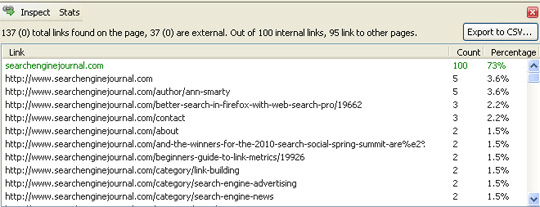 The STATS tab in the same panel allows you to diagnose the page. It evaluates the following criteria:
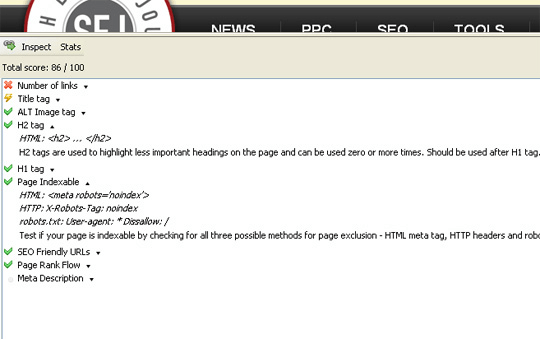 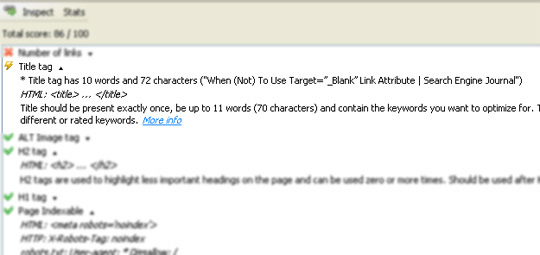 Right-clicking on the status bar numbers allows to quickly access quite a few useful tools and resources:
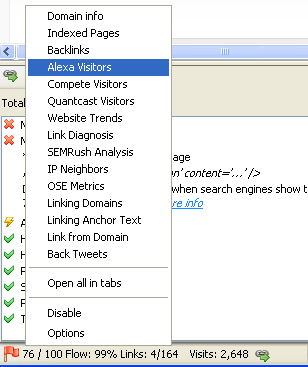 Configure the OptionsThe tool also allows to set a few smart options that include:
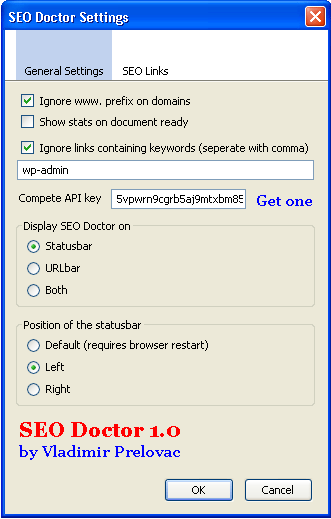 Looks like an awesome tool, doesn’t it? Check out the SEO Tools guide at Search Engine Journal. A New Feature-Rich SEO FireFox Addon: SEO Doctor We've Added a Facebook Like Button to SEJThis week Facebook rolled out some new tools and cupdates to their Open Graph that lets publishers utilize the new Facebook Like option and other Facebook sharing tools on websites, articles and specific web documents. Selena put together a nice wrap up of the announcements here on SEJ.I’m happy to announce that we are now testing the Facebook Like button on SEJ posts, and if you look up, you should see it right above this post. If you click on the Like button, you will not only vote on this post, which may one day positively affect our content as an external social citation metric in the upcoming Facebook search algorithm or whichever engine uses the Facebook data … but you will also share your favorite SEJ posts with your Facebook friends. ESPN.com, IMDB and other major publishers have already launched this tool, and thanks to my good friend Dave Brown, we’re testing a Wordpress Plugin that lets any Wordpress powered blog add the Facebook Like button as well. Dave will have a write up about the Plugin here on SEJ next week, but in the meantime, I’d like to ask for reader feedback. How do you Like the Like button? Check out the SEO Tools guide at Search Engine Journal. We’ve Added a Facebook Like Button to SEJ More Recent Articles |
Sunday, April 25, 2010
A New Feature-Rich SEO FireFox Addon: SEO Doctor
Image support for RSS gadgets
Posted: 23 Apr 2010 07:04 PM PDT This is one of a regular series of posts on search experience updates. Look for the label This week in search and subscribe to the series. - Ed. This week we announced a number of new developments: Search for specific TV show episodes As more and more full-length content is going online, we're making it easier to find the content you want by providing a more structured experience when you search for TV shows. This week, we launched a way to search for specific TV show episodes as part of this effort. Now, when you search for your favorite TV show in Google Videos, check the lefthand toolbar for "Episodes". By clicking on the links in the Search Options panel, you can browse by season to see all episodes, and drill down to see all sources for a specific episode.  Example searches: [desperate housewives] and [the simpsons] Image support for RSS gadgets For many of you who use iGoogle as your homepage, RSS feeds are a great way to get the latest news content, blog updates, recipes and celebrity gossip. And because pictures enhance the online experience, this week we added image support to our iGoogle feed gadgets for people in the U.S. We now support "Slideshow view" as well as "Headline and lead story view." You should notice the change now on your iGoogle page, and you will be able to edit the display setting of each feed by choosing "Edit settings" in the dropdown menu for your feeds.  Slideshow view  Headline and lead story view Example feeds: [CNN], [the economist], [entertainment weekly], [national geographic] Google Places Also this week we announced that the Local Business Center is becoming Google Places. With one out of five searches on Google related to location, we wanted to better connect Place Pages (which launched last September for more than 50 million places globally) to a tool that enables businesses to manage their Google presence. With this change, business owners will benefit from several new ways to expand their online presence, while making it easier for you to make better decisions about local shopping. From real-time coupon updates to interior photos of businesses on place pages, these ongoing enhancements will make local search all the more useful to you. The launch of Google Places is just the beginning of Google becoming more local. If you're a business owner and want to learn more, check out google.com/places. Example place page: [mission mountain winery] Hope you enjoy this week's features. Stay tuned for what's next! Posted by Marissa Mayer, VP Search Products & User Experience |
Official Google Blog
(Cross-posted from the Google Translate Blog) Today we're delighted to announce support for five new languages: Amharic, Tigrinya, Hebrew, Oriya and Sinhalese. This bring the total up to 22 languages spoken across Africa, South Asia, Eastern Europe and the Middle East. These new languages are currently available at http://www.google.com/transliterate. Since you can't use Google Transliteration offline we also launched the transliteration based "Input Method Editor" (IME) earlier this year. Once you download and install the Google Transliteration IME (don't worry, it's free), you can type a word the way it sounds using Roman characters and the software will convert the word to its native script. For example, typing "hamesha" in Google Hindi IME transliterates into Hindi as: हमेशा. As an improvement to the IME, we've recently added 5 more languages (Amharic, Russian, Sanskrit, Serbian and Tigrinya) as well as canonical schemes, macros and support for Windows 64-bit. You can read about all these powerful new features on the Google Transliteration IME help page. Now what if you come across a language that you can speak but can't read? For example, if you can speak Hindi, you may know that "namaste" is a greeting, however you may not be able to read 'नमस्ते' in Hindi script. Our new Script Converter tool converts a given web page or piece of text from one script to another so that you can read it phonetically. Script Converter currently supports 17 languages: Bengali, English, Greek, Gujarati, Hindi, Kannada, Malayalam, Marathi, Nepali, Persian, Punjabi, Russian, Sanskrit, Serbian, Tamil, Telugu and Urdu. So, try out these tools and let us know what you think. Posted by New Melchizedec Sundararaj, Software Engineer |
Subscribe to:
Comments (Atom)



